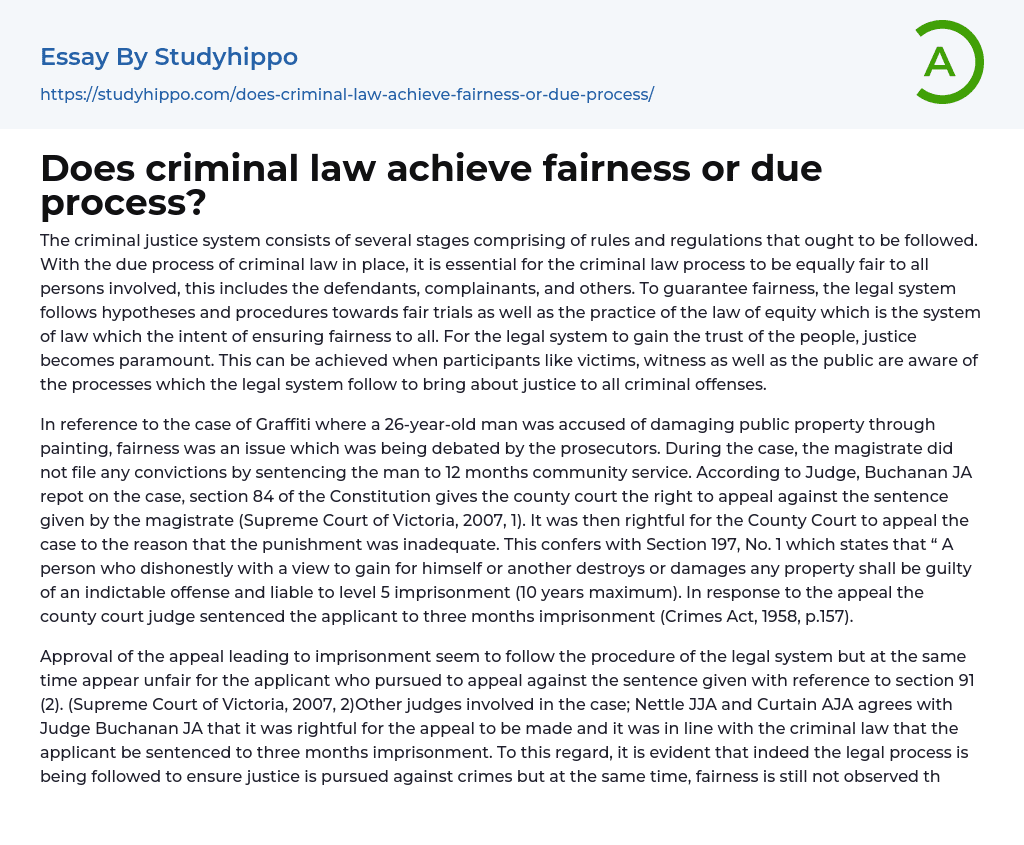

Does criminal law achieve fairness or due process? Essay Example
The criminal justice system consists of several stages comprising of rules and regulations that ought to be followed. With the due process of criminal law in place, it is essential for the criminal law process to be equally fair to all persons involved, this includes the defendants, complainants, and others. To guarantee fairness, the legal system follows hypotheses and procedures towards fair trials as well as the practice of the law of equity which is the system of law which the intent of ensuring fairness to all. For the legal system to gain the trust of the people, justice becomes paramount. This can be achieved when participants like victims, witness as well as the public are aware of the processes which the legal system follow to bring about justice to all criminal offenses.
In reference to the
...case of Graffiti where a 26-year-old man was accused of damaging public property through painting, fairness was an issue which was being debated by the prosecutors. During the case, the magistrate did not file any convictions by sentencing the man to 12 months community service. According to Judge, Buchanan JA repot on the case, section 84 of the Constitution gives the county court the right to appeal against the sentence given by the magistrate (Supreme Court of Victoria, 2007, 1). It was then rightful for the County Court to appeal the case to the reason that the punishment was inadequate. This confers with Section 197, No. 1 which states that “ A person who dishonestly with a view to gain for himself or another destroys or damages any property shall be guilty of an indictable offense and liable to
level 5 imprisonment (10 years maximum). In response to the appeal the county court judge sentenced the applicant to three months imprisonment (Crimes Act, 1958, p.157).
Approval of the appeal leading to imprisonment seem to follow the procedure of the legal system but at the same time appear unfair for the applicant who pursued to appeal against the sentence given with reference to section 91 (2). (Supreme Court of Victoria, 2007, 2)Other judges involved in the case; Nettle JJA and Curtain AJA agrees with Judge Buchanan JA that it was rightful for the appeal to be made and it was in line with the criminal law that the applicant be sentenced to three months imprisonment. To this regard, it is evident that indeed the legal process is being followed to ensure justice is pursued against crimes but at the same time, fairness is still not observed through the appealing processes pursued.
The criminal trial process aims to proof if the crime fits in any of the categories of criminal offense. About the case; mens rea (state of mind of the person at the time of committing the criminal act.). It can be confirmed from the reports by the judges that the act was voluntary in the sense that graffiti was the option which the man took after his effort as a graphic designer faded but ended up damaging public property (Supreme Court of Victoria, 2007, 1). At the same time there was proof of actus reus “the criminal act has occurred”. The combination of the two essential components defined the graffiti case to proceed to judgment.
The legal system, therefore, observes the due process to bring out justice
but at the same time, fairness to its defendants is essential. Graffiti case could end up the man being sentenced to 10 years incarceration if the criminal act was followed but for fairness 3months imprisonment was given. It can be concluded that indeed the criminal law has to an extent achieved fairness towards justice.
References
Supreme Court of Victoria. Director of Public Prosecution vs Naom Jason Shoan. Court Of Appeal. No 289 of 2007
Crimes Act. Division-3 Criminal Damage to Property. No. 6231 of 1958



